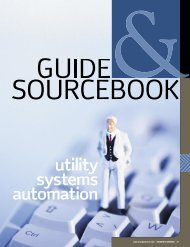FERC vs NERC: A grid control showdown over cyber security
FERC vs NERC: A grid control showdown over cyber security
FERC vs NERC: A grid control showdown over cyber security
You also want an ePaper? Increase the reach of your titles
YUMPU automatically turns print PDFs into web optimized ePapers that Google loves.
TRANSMISSIONS<br />
WWW.INTELLIGENTUTILITY.COM /// JULY/AUGUST 2011<br />
6<br />
Vol 3, issue 3 » mAy/June 2011<br />
Letters from readers<br />
smARt sm smARt t gRiD gR gRiD iD<br />
2020<br />
©<br />
Industry experts weigh<br />
in on critical trends<br />
tRAnsmission<br />
inteRconnection<br />
two new developments<br />
putting the brakes on buildout<br />
eneRgy eFFiciency impAct<br />
How DR + ee is more than<br />
the sum of their parts<br />
where smart <strong>grid</strong> meets business—and reality.<br />
cis/mDm<br />
utility barriers still exist<br />
» www.intelligentutility.com<br />
Grid modernization<br />
monetization<br />
March/April 2011<br />
Thank you for the interesting article<br />
on ROCs. I had not previously heard<br />
of this sort of financial instrument,<br />
although it sounds a lot like a municipal<br />
revenue bond. Those instruments<br />
are tax-free and are low risk because<br />
of the dedication of project revenues<br />
to repay the debt. I like the long-term,<br />
stable source of capital that an ROC<br />
represents so that the payment stream<br />
can be more stable.<br />
I am curious about a few things.<br />
Firstly, long-term finance and amortization<br />
is common in the utility sector,<br />
but with smart <strong>grid</strong> assets the steep<br />
technology curve dictates much shorter<br />
amortization periods like 10 years instead<br />
of the typical 30. If the underlying<br />
assets become no longer useful before<br />
the debt is repaid, how is the remaining<br />
balance paid? In utility ratemaking,<br />
utilities can only have assets that are<br />
used and useful in rate base.<br />
I understand from a credit standpoint<br />
why the instrument’s marketability<br />
and lower interest rate is tied to<br />
the dedicated charge on consumers’<br />
bills along with a true-up mechanism<br />
and assurance from regulators that<br />
the deal will be honored <strong>over</strong> the term<br />
of the loan. However, this very issue<br />
of providing assured cost rec<strong>over</strong>y, or<br />
prudence, is a major issue for regulators<br />
as evidenced best in the initial<br />
order last June from the Maryland<br />
Commission re: denying BG&E cost<br />
rec<strong>over</strong>y for its AMI project.<br />
I am intrigued by the ROC, but<br />
wonder what thought has been given<br />
to satisfying or assuring regulators<br />
relative to performance, ratepayer<br />
benefit that would convince a PUC to<br />
provide the sort of iron-clad support<br />
contemplated in an ROC? Have any<br />
ROCs been placed at this point that<br />
would be instructive along these lines?<br />
David O’Brien<br />
Director Regulatory Strategy<br />
Bridge Energy Group<br />
Changing the<br />
dispatch equation<br />
March/April 2011<br />
We continue to look at our mounting<br />
problems through the lens that we<br />
have used since the <strong>grid</strong> was created.<br />
“We need to bring more data into<br />
the equation and find a way for<br />
dispatchers to manage it,” the gist of<br />
this article, is based on a top-down,<br />
center-based <strong>control</strong> paradigm. We<br />
need much more data, that is certainly<br />
true, but more data will <strong>over</strong>whelm<br />
our current system. Consider how<br />
the Internet manages complexity and<br />
massive amounts of data. The communication<br />
protocols of the Internet<br />
(TCP/IP, etc.) enable massive amounts<br />
of data to self-route. They provide<br />
an appropriate network architecture<br />
to manage complexity and, in so<br />
doing, unleash tremendous potential<br />
for innovation and, importantly for<br />
www.intelligentutility.com<br />
EDITOR-IN-CHIEF Kate Rowland<br />
krowland@energycentral.com 720.331.3555<br />
SENIOR CONTRIBUTORS<br />
Phil Carson<br />
Editor-in-chief, Intelligent Utility Daily<br />
pcarson@energycentral.com 303.228.4757<br />
Christopher Perdue<br />
Vice President, Sierra Energy Group<br />
cperdue@energycentral.com 310.471.7396<br />
FEATURE WRITERS<br />
Mike Breslin, John Johnson, Phil Johnson, Laurel Lundstrom,<br />
Elizabeth McGowan, Cate Meredith<br />
COPY EDITORS: Martha Collins, J. Ian Tennant<br />
VICE PRESIDENT, SALES/MARKETING SERVICES: Jennifer LaFlam<br />
jlaflam@energycentral.com 800.459.2233<br />
ACCOUNT EXECUTIVES<br />
Jean Micketti, Ken Maness, Todd Hagen<br />
sales@energycentral.com 800.459.2233<br />
ADVERTISING COORDINATORS<br />
Eric Swanson, Stephanie Wilson, Patricia Davis<br />
CUSTOMER SERVICE<br />
Cindy Witwer, 800.459.2233<br />
ENERGY CENTRAL<br />
www.EnergyCentral.com<br />
PRESIDENT/CEO Steve Drazga<br />
CHIEF OPERATING OFFICER Steven D. Solove<br />
CHIEF DIGITAL OFFICER Joe Haddock<br />
VICE PRESIDENT, INTELLIGENT UTILITY Mark Johnson<br />
VICE PRESIDENT, DATA & ANALYSIS Randy Rischard<br />
VICE PRESIDENT, MARKETING PRACTICES Mike Smith<br />
DIRECTOR OF MARKETING Sarah W. Frazier<br />
DIRECTOR OF SALES, EMPLOYMENT SERVICES Kyle Schnurbusch<br />
2821 S. PARKER RD., SUITE 1105<br />
AURORA, CO 80014<br />
PHONE 303.782.5510<br />
ADVERTISING AND REPRINT REQUESTS<br />
Please call 800.459.2233 or email sales@energycentral.com<br />
Intelligent Utility is available free to a limited number<br />
of qualified subscribers. Basic subscription rates are<br />
$99/year within the US and $129/year outside the US.<br />
Single copies are $10 plus S/H.<br />
Subscribe online at www.IntelligentUtility.com/SUBSCRIBE<br />
GEOSPATIAL PARTNER<br />
Official Association Partners<br />
UTILITY ICT PARTNER<br />
ADVANCED METERING PARTNER ENERGY EFFICIENCY PARTNER


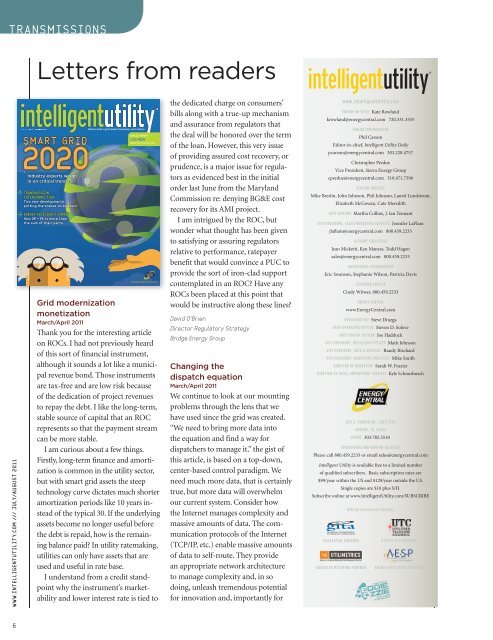
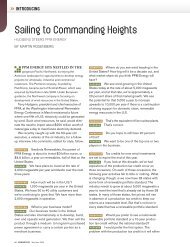

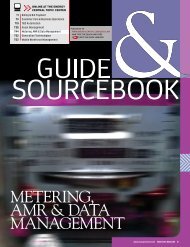

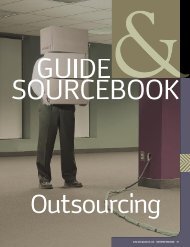



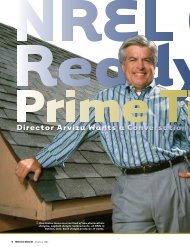



![View From the Trenches [PDF]](https://img.yumpu.com/18854438/1/190x252/view-from-the-trenches-pdf.jpg?quality=85)
